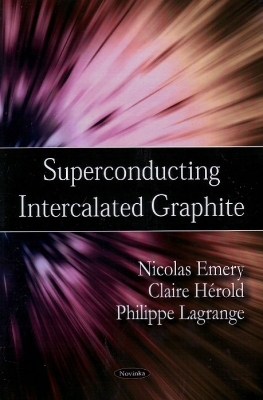
Superconducting Intercalated Graphite
Seiten
2009
Nova Science Publishers Inc (Verlag)
978-1-60456-609-3 (ISBN)
Nova Science Publishers Inc (Verlag)
978-1-60456-609-3 (ISBN)
Offers an introduction to the various carbon materials. This title reviews the features of the intercalation reaction into graphite. It reviews the binary compounds, emphasising their crystal and electronic structures and also their transport properties. It describes the superconductivity of the various compounds belonging to this family.
The discovery in 2005 of superconductivity in YbC6 and CaC6, with substantially higher critical temperatures than the previously observed among the family of the graphite intercalation compounds, has largely renewed the interest for these well known lamellar compounds. Indeed, these critical temperatures reach 6.5 and 11.5 K respectively for ytterbium- and calcium-graphite phases. It was consequently interesting to collect all the informations concerning the superconductivity of these compounds from the discovery of this phenomenon observed in the heavy alkali metals graphite intercalation compounds in 1965, insisting particularly on the recent advances in this research field. After a general introduction that describes all the carbon materials, which are extremely various with dimensionalities varying from 3 to 0, leading to their large aptitude for the insertion/intercalation reactions, the authors widely developed the case of graphite: chemical bonds, crystal and electronic structures, anisotropy and ability to become a host structure. The authors insist on its strong anisotropy of chemical reactivity that allows the synthesis of very numerous intercalation compounds. The distinctive features of the intercalation reaction into graphite are reviewed (systematic charge transfer, staging, etc...) and are particularly developed in the case of the donor-type intercalation compounds, among which is precisely observed the superconductivity. For the latter, the various synthesis methods are successively described, showing the best route to use in order to obtain each type of compound. Then the authors review with detail the binary compounds, emphasising their distinctive crystal and electronic structures and also their transport properties. The authors describe the superconductivity of all the compounds belonging to this family and show this property. In the last part, the authors compare these superconducting binary intercalated graphite compounds with other lamellar superconductor: magnesium diboride. The ternary compounds are then studied, and the poly-layered nature of their intercalated sheets is given special attention. Their distinctive electronic structure is presented and their superconducting properties are described.
The discovery in 2005 of superconductivity in YbC6 and CaC6, with substantially higher critical temperatures than the previously observed among the family of the graphite intercalation compounds, has largely renewed the interest for these well known lamellar compounds. Indeed, these critical temperatures reach 6.5 and 11.5 K respectively for ytterbium- and calcium-graphite phases. It was consequently interesting to collect all the informations concerning the superconductivity of these compounds from the discovery of this phenomenon observed in the heavy alkali metals graphite intercalation compounds in 1965, insisting particularly on the recent advances in this research field. After a general introduction that describes all the carbon materials, which are extremely various with dimensionalities varying from 3 to 0, leading to their large aptitude for the insertion/intercalation reactions, the authors widely developed the case of graphite: chemical bonds, crystal and electronic structures, anisotropy and ability to become a host structure. The authors insist on its strong anisotropy of chemical reactivity that allows the synthesis of very numerous intercalation compounds. The distinctive features of the intercalation reaction into graphite are reviewed (systematic charge transfer, staging, etc...) and are particularly developed in the case of the donor-type intercalation compounds, among which is precisely observed the superconductivity. For the latter, the various synthesis methods are successively described, showing the best route to use in order to obtain each type of compound. Then the authors review with detail the binary compounds, emphasising their distinctive crystal and electronic structures and also their transport properties. The authors describe the superconductivity of all the compounds belonging to this family and show this property. In the last part, the authors compare these superconducting binary intercalated graphite compounds with other lamellar superconductor: magnesium diboride. The ternary compounds are then studied, and the poly-layered nature of their intercalated sheets is given special attention. Their distinctive electronic structure is presented and their superconducting properties are described.
Preface; General Introduction about Carbon Materials; Graphite: Variety, Bonds, Crystalline and Electronic Structures, Anisotropy and Material Considered as a Host Structure; Chemical Anisotropy; Donor-Type Graphite Intercalation Compounds; Binary Graphite Intercalation Compounds; Superconductivity of Binary Graphite Intercalation Compounds; Ternary Graphite Intercalation Compounds; Superconductivity of Ternary Graphite Intercalation Compounds; Short General Idea about the Superconductivity of the Other Intercalated Carbon Materials; Conclusion; References; Index.
| Erscheint lt. Verlag | 5.3.2009 |
|---|---|
| Zusatzinfo | Illustrations |
| Verlagsort | New York |
| Sprache | englisch |
| Maße | 230 x 155 mm |
| Gewicht | 178 g |
| Themenwelt | Naturwissenschaften ► Physik / Astronomie ► Elektrodynamik |
| ISBN-10 | 1-60456-609-4 / 1604566094 |
| ISBN-13 | 978-1-60456-609-3 / 9781604566093 |
| Zustand | Neuware |
| Haben Sie eine Frage zum Produkt? |
Mehr entdecken
aus dem Bereich
aus dem Bereich
eine Einführung in die Gleich- und Wechselstromtechnik
Buch | Hardcover (2024)
Hanser (Verlag)
CHF 48,95
Grundlagen und praktische Anwendungen
Buch | Hardcover (2022)
Hanser (Verlag)
CHF 48,95


